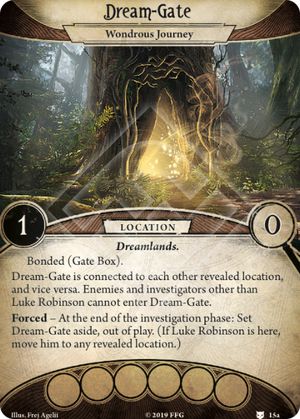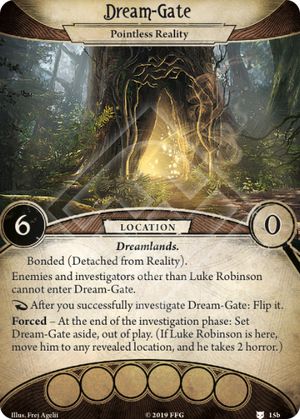-
Q: Can I play an Ethereal Slip in the Dream-Gate? What would happen if it could be played? A: If you played Ethereal Slip while in Dream-Gate, nothing would happen, because Dream-Gate prevents enemies from entering it. Swapping places would not be possible.
-
Q: After playing Read the Signs in Dream-Gate, can I still play Practice Makes Perfect during the Skill Test? Or, can I continue to play a Crack the Case after discovering the last remaining clues? A: To answer your other questions literally, there is nothing on Dream-Gate that would prevent you from playing Read the Signs and then Practice Makes Perfect to investigate there, at Dream-Gate. (It wouldn’t make sense to play Crack the Case”after this interaction, though.) Now, if you were asking about using Luke Robinson’s ability to investigate any revealed location while in Dream-Gate, that’s a little different. In summary, you would be able to play each of the cards you mentioned, so long as their conditions are met. Let’s say you are playing Luke Robinson and are currently in Dream-Gate. Per its ability text, Dream-Gate is connected to each other revealed location. Luke Robinson’s ability allows you to play one event each turn as if you were at a connecting location and engaged with each enemy at that location. “As if” is a phrasing that alters the game state in the manner described for the duration described—in other words, you can play an event card during your turn and essentially act as if you are in that location until the event card is fully resolved. You decide your event for the turn is Read the Signs, and thanks to being in Dream-Gate, you are able to investigate at any revealed location, and act as if you are in that location. There is a window of opportunity before the card fully resolves where you can play a “Fast” event card and create what’s known as a “nested sequence.” All of that to say, Practice Makes Perfect would be valid in the location you are investigating; you can resolve it while the “as if” condition is altering the game state. You could also play Crack the Case if the last remaining clue was discovered at that location during the investigation action of Read the Signs.
-
Q: If Luke Robinson is already in the Dream-Gate and cannot move for some reason at the same time (for example, already in the Dream-Gate, the Mythos phase draws Entombed), at the end of the investigation phase, how is the forced ability of the Dream-Gate resolved? A: Unless explicitly specified, investigators cannot be at “no location.” If Luke is Entombed while in Dream-Gate when the investigation phase ends, Dream-Gate must be set aside, so you may ignore Entombed’s effect long enough to place Luke in a revealed location that’s in play.
-
Q: It seems like the concealed rules conflict with the intention of Luke's Dream-Gate location. If a concealed mini card can spawn in the Dream-Gate, you can realize it was the monster all along, or the Dream-Gate can leave play with the true location mini card, thus discarding it? How should concealed mini cards interact with Luke? A: Concealed mini-cards should not be placed in Dream-Gate. Given that enemies can never enter or spawn in Dream-Gate, concealed mini-cards should not be able to either. We are planning to explicitly state this in the next FAQ.
-
Q: Can an enemy spawn or move into Dream-Gate while Luke Robinson is at Dream-Gate? A: Enemies cannot spawn at Dream-Gate. If an enemy would spawn at Luke Robinson’s location while he is at Dream-Gate, it is discarded instead. If Luke Robinson moves into Dream-Gate while engaged with an enemy, that enemy disengages (but does not exhaust) and does not move with him. While at Dream-Gate, Luke Robinson cannot be chosen as an investigator for the purposes of enemy movement. - FAQ, v.2.1, August 2023
-
Q: If Luke Robinson has Entombed in his threat area when the Forced effect on Dream-Gate triggers, what happens? A: While Entombed would prevent Luke Robinson from moving, an investigator cannot be at “no location” unless explicitly stated. When Dream-Gate’s forced effect would move Luke Robinson at the investigation phase, you may ignore the effect on Entombed long enough to place Luke in a revealed location. - FAQ, v.2.1, August 2023
Portail Onirique
Merveilleux Voyage
Lieu
Contrées du Rêve.
Liée (Boîte à Portail).
Le Portail Onirique est connexe à chaque autre lieu révélé et vice versa. Les Ennemis et les investigateurs autres que Luke Robinson ne peuvent pas entrer dans le Portail Onirique.
Forcé – À la fin de la phase d'Investigation : mettez le Portail Onirique de côté, hors jeu. (Si Luke Robinson s'y trouve, déplacez-le vers n'importe quel lieu révélé.)
Portail Onirique
Futile Réalité
Lieu
Contrées du Rêve.
Liée (Détaché de la Réalité).
Les Ennemis et les investigateurs autres que Luke Robinson ne peuvent pas entrer dans le Portail Onirique.
Après avoir enquêté avec succès dans le Portail Onirique, retournez-le.
Forcé – À la fin de la phase d'Investigation : mettez le Portail Onirique de côté, hors jeu. (Si Luke Robinson s'y trouve, déplacez-le vers n'importe quel lieu révélé et il subit 2 horreurs.)


Bonded Cards
- Gate Box: Worlds within Worlds (Les Dévoreurs de Rêves #13)
FAQs
(from the official FAQ or responses to the official rules question form)Reviews
When you're using Luke Robinson you can play Event for the connecting location. So any event with Investigate is usable for this case.
For Example:
Combo with Fieldwork touse Read the Signs to guarantee success with 9 skill (+2 skill,4 Will, 3 Intellect) to deal target Shroud.Combo with Fieldwork touse Seeking Answers to guarantee success with 5 skill (+2, 3 Intellect) to 1 Shroud here, Dream-Gate: Pointless Reality Note: I get the correct image for anyone who uncomfortable with mistake like me.
Update: Fix misunderstood of Fieldwork
Note
- This is the correct version of Dream-Gate: Wondrous Journey on another site.
Just want to point out the picture of Dream-Gate (Wondrous Journey) is wrong. This page shows Dream-Game (Pointless reality) twice. There's a sweet combo with Hawk-Eye Folding Camera and Vantage Point. You use your Gate Box, then Dream-Gate enters play. You play Vantage Point to move a clue to Dream-Gate and its shroud becomes 0. You investigate to remove the 'last clue' from your location and put a resource on Hawk-Eye Camera.
It is first player card which allows you to banish clues in game. Simply place your clues at this location, and wait until this location is set aside; then, clues on this location are banished. Note that all player cards (except this) don't spend any clues and only place clues on your locations to keep the total number of clues in game. You can do by using Vantage Point, Dr. William T. Maleson, Forewarned, Quick Study. or by eliminating in this location with Ghastly Revelation or "I'm outta here!".
You don't need to do in most cases, and have to avoid this situration in order not to break the game. When this is useful? 1) for a dunwich scenario, 2) if you're a cultist, and ...
Is Dream-gate an encounter card? Seems like it function like one when in play. I asked and Maxine clarified for us:
Greetings,
Good question! In this case, I would say that while Dream-Gate is in play, it is an encounter card, since it is a location and location cards are generally encounter cards. However, while it is set aside and out of play it functions more like a player card, for deckbuilding purposes and the like. So if Gate Box moves you, that is a player card effect moving you, but when Dream-Gate moves you, that would be an encounter card effect moving you.
Hope that helps!
MJ Newman (she/they) Senior Game Designer